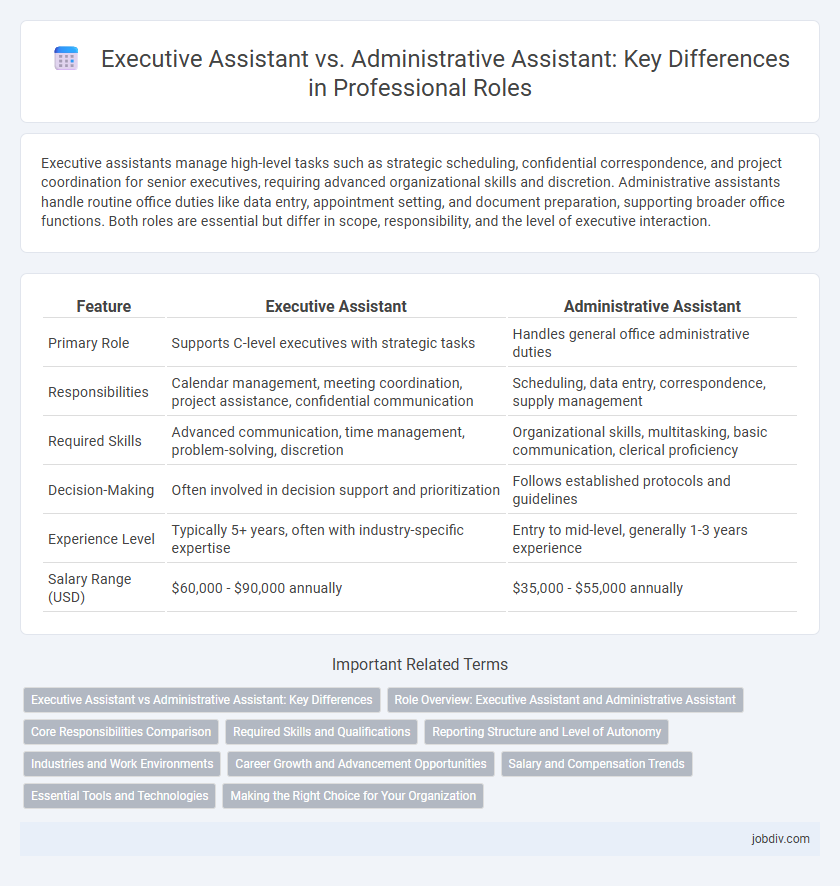Executive assistants manage high-level tasks such as strategic scheduling, confidential correspondence, and project coordination for senior executives, requiring advanced organizational skills and discretion. Administrative assistants handle routine office duties like data entry, appointment setting, and document preparation, supporting broader office functions. Both roles are essential but differ in scope, responsibility, and the level of executive interaction.
Table of Comparison
| Feature | Executive Assistant | Administrative Assistant |
|---|---|---|
| Primary Role | Supports C-level executives with strategic tasks | Handles general office administrative duties |
| Responsibilities | Calendar management, meeting coordination, project assistance, confidential communication | Scheduling, data entry, correspondence, supply management |
| Required Skills | Advanced communication, time management, problem-solving, discretion | Organizational skills, multitasking, basic communication, clerical proficiency |
| Decision-Making | Often involved in decision support and prioritization | Follows established protocols and guidelines |
| Experience Level | Typically 5+ years, often with industry-specific expertise | Entry to mid-level, generally 1-3 years experience |
| Salary Range (USD) | $60,000 - $90,000 annually | $35,000 - $55,000 annually |
Executive Assistant vs Administrative Assistant: Key Differences
Executive Assistants manage high-level administrative tasks including calendar management, strategic communications, and project oversight for senior executives, requiring advanced organizational skills and discretion. Administrative Assistants focus on routine office duties such as scheduling appointments, handling correspondence, and maintaining records, supporting broader office functions. The key differences lie in the scope of responsibilities, with Executive Assistants playing a critical role in decision-making processes and Administrative Assistants providing essential support to ensure daily operational efficiency.
Role Overview: Executive Assistant and Administrative Assistant
Executive Assistants manage complex schedules, coordinate high-level meetings, and handle confidential communications for top executives, requiring advanced organizational and decision-making skills. Administrative Assistants provide essential support by managing routine clerical tasks, maintaining office operations, and assisting multiple departments to ensure smooth workflow. Both roles demand strong communication abilities but differ in scope and responsibility, with Executive Assistants focusing on strategic support and Administrative Assistants on operational efficiency.
Core Responsibilities Comparison
Executive Assistants manage complex scheduling, coordinate high-level meetings, and handle confidential communications for senior executives, ensuring seamless executive operations. Administrative Assistants support daily office functions such as organizing files, managing correspondence, and assisting multiple staff members with routine tasks. The Executive Assistant role demands strategic decision-making skills and a proactive approach, while the Administrative Assistant focuses on operational efficiency and administrative support.
Required Skills and Qualifications
Executive Assistants require advanced organizational skills, proficiency in high-level communication, and the ability to manage complex schedules, often supporting C-suite executives. Administrative Assistants need strong multitasking abilities, proficiency with office software, and effective interpersonal skills to handle routine office tasks and support departmental functions. Both roles demand discretion, time management, and adaptability, but Executive Assistants typically require more strategic thinking and executive-level experience.
Reporting Structure and Level of Autonomy
An Executive Assistant typically reports directly to senior executives such as CEOs or vice presidents, reflecting a higher level of responsibility and access to confidential information. They operate with significant autonomy, managing complex schedules, decision-making support, and strategic communications independently. In contrast, an Administrative Assistant usually reports to mid-level managers or department heads and follows more structured guidelines with limited decision-making authority.
Industries and Work Environments
Executive Assistants typically operate in high-level corporate environments such as finance, legal, and technology sectors, supporting C-suite executives with strategic tasks and confidential communications. Administrative Assistants are more prevalent across diverse industries including healthcare, education, and government, managing routine office tasks and scheduling for various teams. The work environment for Executive Assistants often demands discretion and advanced problem-solving skills, while Administrative Assistants focus on organizational efficiency and multitasking within broader operational settings.
Career Growth and Advancement Opportunities
Executive assistants often experience faster career growth and greater advancement opportunities due to their direct support to high-level executives and involvement in strategic decision-making. Administrative assistants typically have a broader range of routine tasks but may face slower upward mobility without specialized skills or additional qualifications. Developing strong organizational, communication, and project management skills significantly enhances career prospects in both roles.
Salary and Compensation Trends
Executive Assistants generally earn higher salaries than Administrative Assistants due to their advanced responsibilities and direct support to top-level management. Salary ranges for Executive Assistants typically fall between $60,000 and $90,000 annually, while Administrative Assistants earn approximately $35,000 to $55,000 per year. Compensation trends indicate growing demand for Executive Assistants with specialized skills, driving competitive pay and enhanced benefits packages.
Essential Tools and Technologies
Executive Assistants and Administrative Assistants rely heavily on productivity software such as Microsoft Office Suite and Google Workspace to manage calendars, emails, and documents efficiently. Advanced tools like project management platforms (Asana, Trello) and communication software (Slack, MS Teams) are essential for Executive Assistants handling complex coordination and team collaboration. Both roles increasingly utilize cloud-based file storage (Dropbox, OneDrive) and scheduling tools (Calendly, Doodle) to optimize workflow and ensure seamless organization.
Making the Right Choice for Your Organization
Choosing between an Executive Assistant and an Administrative Assistant depends on the complexity of organizational needs and the level of support required by senior leadership. Executive Assistants handle high-level tasks such as strategic calendar management, confidential communication, and project coordination, while Administrative Assistants focus on routine office operations, scheduling, and clerical support. Aligning the role with company goals ensures efficient workflow, effective leadership support, and optimized resource allocation.
Executive Assistant vs Administrative Assistant Infographic

 jobdiv.com
jobdiv.com